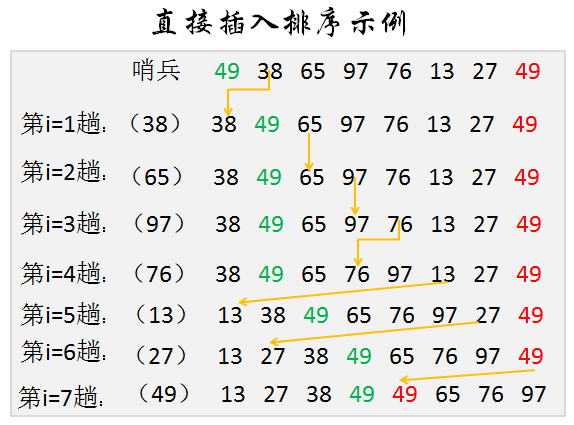插入排序
一. 直接插入排序(稳定)
算法原理
将一个记录插入到已经排好序的有序表中,从而得到一个新的,长度增加1的有序表。
【每遍操作】
现将元素复制到0号位置(哨兵),再将本元素同已排序的序列,从尾开始比较。在已排序的序列中寻找自己的位置,进行插入;或者寻找不到,则一直进行到哨兵为止,即本元素最小,应放置在1号位置。

算法代码
template <typename Comparable> void insertSort( vector<Comparable>& a ) { for ( int i = 1; i < a.size(); ++i ) { Comparable temp = a[i]; int j = i - 1; for ( ; j >= 0 &&a[j] > temp ; --j) a[j+1] = a[j]; a[j+1] = temp; } }
python版本
def insertSort(data): """直接插入排序(有小到大)""" n = len(data) for i in range(1, n): temp = data[i] j = i - 1 while j >= 0 and data[j] > temp: data[j+1] = data[j] j -= 1 data[j+1] = temp return data
性能分析:
空间复杂度O(1)
时间复杂度:O(N2)
- 正序时:比较次数n-1次,移动次数0次
- 逆序时:比较次数和移动次数都是O(N2)
二. 折半插入排序(稳定)
算法原理
在插入排序基础上进行改进。每次在有序表中查找插入位置时,不按照顺序挨个查找,而是先与有序表中中间的元素进行比较,这样可以查找范围缩至原来的一半。
需要注意的问题
【具体操作】
在将一个新元素插入有序表中时,将首元素设为a[low],末元素设为a[high],将待插入元素a[i]
与中间元素m=(low+high)/2相比较,如果比它大,则更新low = m+1,否则 high = m-1,直到low<=high不成立,即将此位置之后所有元素后移一位,并将新元素插入到a[high+1].
需要注意的问题
1.必须采用顺序存储方式
2.折半插入排序的比较次数与记录移动次数与初始状态无关,仅依赖于记录的个数。
算法代码
1 void halfInsertSort ( vector<Comparable>& a ) 2 { 3 for (int i = 1; i < a.size(); ++i) 4 { 5 Comparable temp = a[i]; 6 int low = 0, high = i-1; 7 while ( low <= high ) 8 { 9 int mid = ( low + high ) / 2; 10 if ( a[mid] <= temp ) 11 low = mid + 1; 12 else 13 high = mid - 1; 14 }//插入位置为low,low到i-1的元素后移 15 for ( int j = i - 1; j >= low; --j ) 16 a[j+1] = a[j]; 17 a[low] = temp; 18 } 19 }
python版本
def halfInsertSort(data): """折半插入""" for i in range(1, len(data)): temp = data[i] low, high = 0, i-1 while low <= high: mid = (low + high) // 2 if data[mid] <= temp: low = mid + 1 else: high = mid - 1 # 插入位置为low, low~i-1后的元素后移 for j in range(i-1, low-1, -1): data[j+1] = data[j] data[low] = temp return data
算法性能
- 时间复杂度:O(N2)
- 空间复杂度:O(1)
- 优势:减少比较次数,移动次数不变
三.希尔排序
template< typename Comparable > void shellSort (vector<Comparable>&a) {//使用希尔增量,a.size()/2, a.size()/4,...1 for (int gap = a.size()/2; gap > 0; gap /= 2) for (int i = gap; i < a.size(); ++i) { Comparable temp = a[i]; int j = i-gap; for (; j >= 0 && a[j] > temp; j-=gap)//直接插入法 a[j+gap] = a[j];//边查找边后移 a[j+gap] = temp; } }



